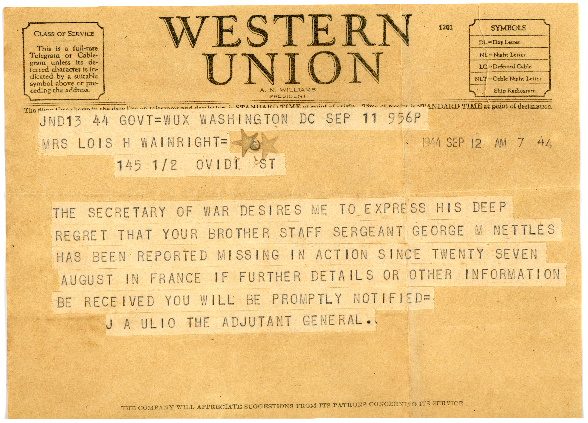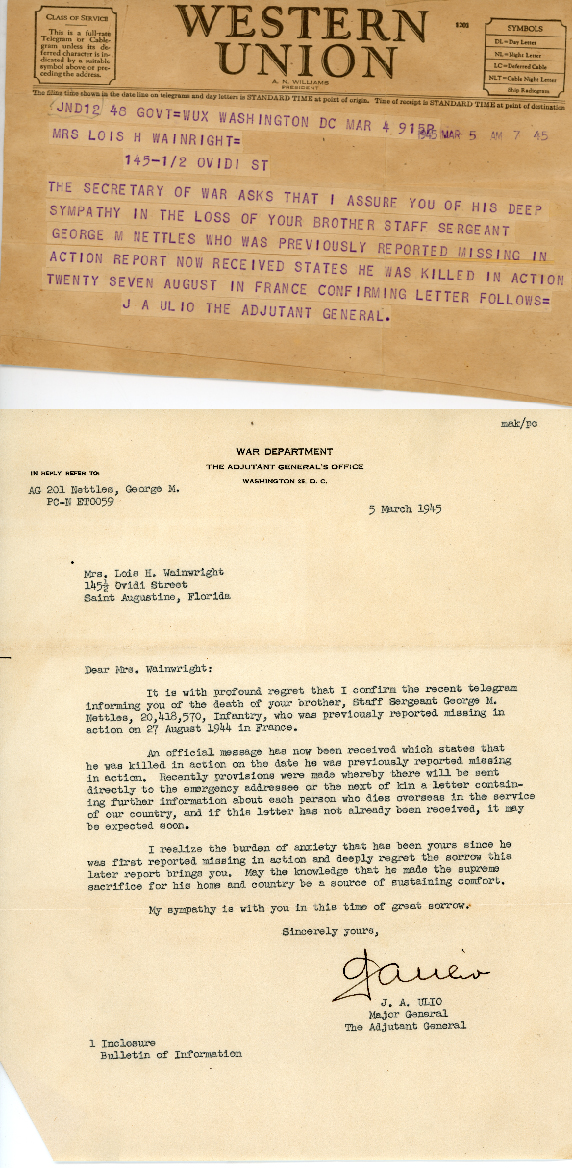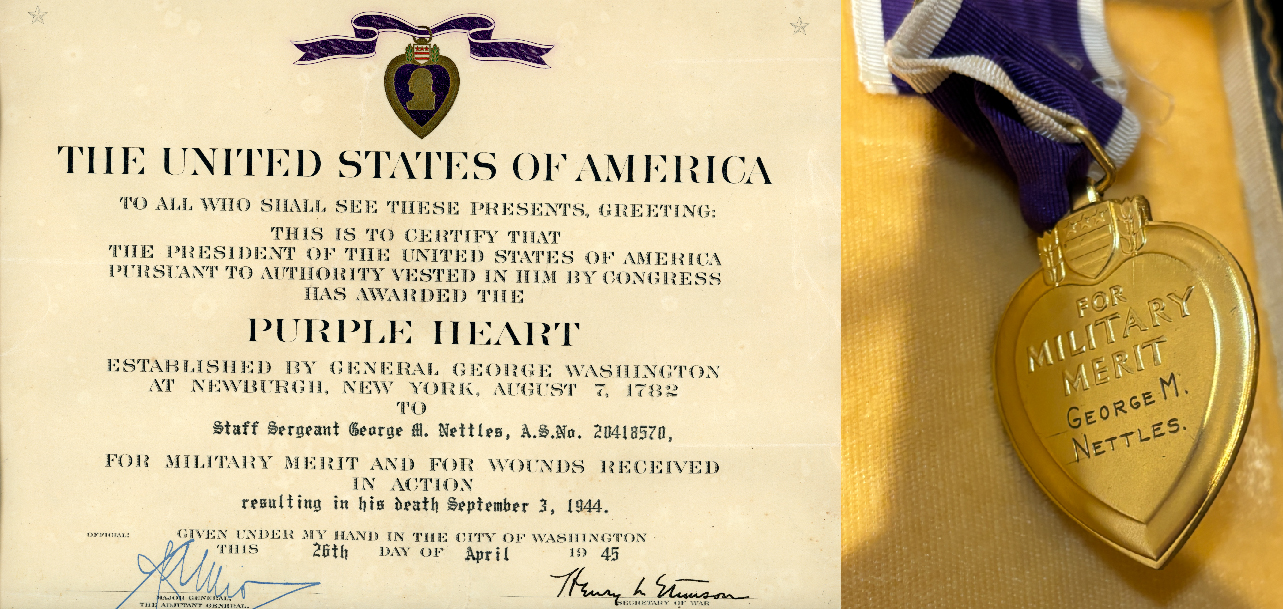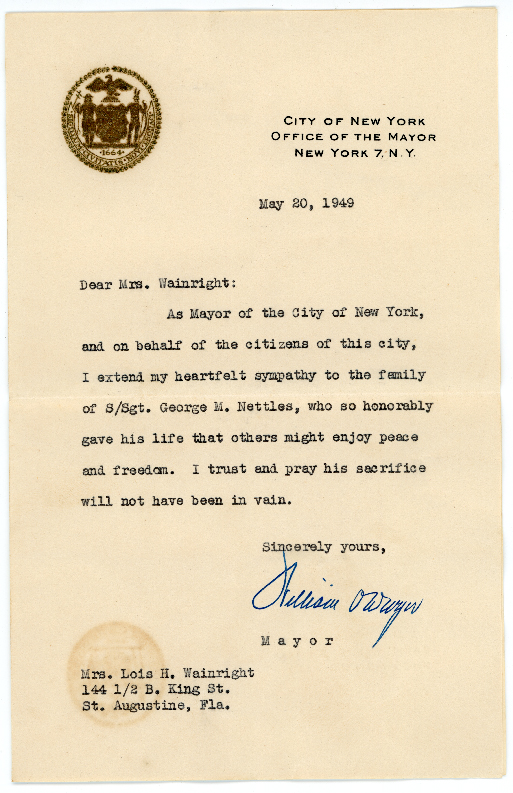George Monroe Nettles (February 27, 1925-September 3, 1944)
119th Infantry Regiment, 30th Infantry Division
By Lisa Warren and Katherine Thurlow
Early Life
George Monroe Nettles was born on February 27, 1925 in Smoaks, SC to Alfred and Georgette Nettles.1 He was the seventh of eight children and likely named after his mother.2 Both of his parents were born and raised in South Carolina and married around 1905.3 Alfred and Georgette rented their home and worked as agricultural laborers, often called sharecropping during this era.4 By 1920, the couple had five more children- Margaret (born in approximately 1907), Ruth (1908), Rutledge (1910), Nellie (1914) and Lois (1918).5 By 1920, the family had moved from Bell Township to nearby Warren township where they rented a home and Alfred worked as a farm operator also known as a sharecropper.6 By 1930, they had moved to Lodge, SC where Alfred worked on W.W. Cone’s farm.7 He and Georgette had another daughter, Laura (1929), and two more boys, George (1925) and his younger brother, Donald (1930).8
Unfortunately, tragedy struck George’s family in 1930. The Great Depression devastated farmers across the country. Crop prices fell drastically, and consumers could not afford to purchase crops, leading to a crop surplus and economic hardships for many farmers. This made life particularly difficult for tenant sharecroppers like the Nettles family.9 Although the newspapers include conflicting accounts, The Nettles’ and the Cones’ disagreement about the farm’s mortgage turned violent. Spurred by economic turmoil and difficulties at the height of the Great Depression, it appears the Nettles family could not make contributions to the Cone’s mortgage.10 Following an argument over a portion of the corn crop, W.W. Cone shot and killed Georgette Nettles, as she sought to defend her family, and mortally wounded Alfred, who died later in the hospital.11 Their oldest son, Rutledge, defending his parents, shot and killed W. W. Cone.12 Both Rutledge Nettles and Bernard Cone (W.W. Cone’s brother) were arrested and released on bail.13
After enduring this unimaginable tragedy, Nellie, Laura, and George moved in with Margaret, their older sister, and her husband Jacob in Duval County, FL.14 Donald, not even a year old when his parents died, was adopted by James Crosby and his farming family and stayed in South Carolina.15 By 1940, Lois lived with Ruth, another older sister, and her husband, Sam Collier, in St. Johns County, FL.16 Sixteen year old George moved in with Rutledge and his wife and children in St. Augustine, FL. Rutledge worked as an attendant at a storage company. George completed sixth grade before working as a plumber for twelve dollars a week.17
Military Service
George enlisted in the Florida National Guard in St. Augustine in the Service Company, 124th Infantry Regiment on July 23, 1940.18 Lying about his age, his enlistment record indicated he was born in 1922.19 The 124th Regiment, nicknamed the “Gators,” was inducted into federal service on November 25, 1940.20 The Service Co., split into three different sections: the staff section, the transportation section, and the supply section. According to the unit history, the Service Co. was the “cream of the regiment” and consistently lived up to their motto: “as Service Company goes, so goes the regiment.”21
At some point, George shifted from the 124th Regiment and joined the 119th Infantry Regiment, part of the 30th Infantry Division (ID), the Old Hickory Division. On December 7, 1942, the 119th began the first two phases of mobilization training at Camp Blanding, FL. By June 1943, the 119th moved to Camp Forrest, TN to finish the third phase of their training. The regiment so thoroughly impressed the War Department with its score on the War Department Training Test record that Nettles and his comrades were quickly groomed for action. On June 10, 1943, the Army bestowed World War I battle honors on the reactivated 119th Infantry Regiment. This included awards for breaking the Hindenburg Line and numerous other accolades.22
The final phase of training took place in Murfreesboro, TN, lasting between September and October 1943. The regiment moved to Camp Atterbury, IN before sailing out of the Boston Harbor on February 12, 1944 aboard the US Army Transport Brazil. After the 119th arrived in Southeastern England, its soldiers received more training in “bayonet and knife fighting, in dirty fighting, in destruction of equipment, in chemical warfare, in aircraft identification, in squad tactics, mines, the selections of observation posts, and so on.”23
In June 1944, just a few days after the initial D-day landings and as part of the larger Battle for Normandy, the 119th landed on Omaha Beach, before moving further into the Cotentin Peninsula. Over the next month, the 119th and the rest of the 30th ID helped the Allies liberate parts of Normandy including St. Lô in July 1944 as part of Operation Cobra. Nettles and the rest of the Allied infantry divisions fought through rural Norman communities, which, due to the walls and hedges that demarcated small family farms, gave the Germans a tactical advantage. The landscape earned these fights another nickname, the Battle for the Hedgerows. 24

Then, in late August, after participating in the liberation of Brittany, the 119th headed east to provide reinforcements for the 2nd Armored Division near Louviers, about sixty-five miles northwest of Paris. By the time the troops reached the assembly area to the west of Louviers, on August 25, the same day Allied forces entered Paris, they received orders to withdraw south. While crossing the Seine River on the morning of August 27, Nettles and his comrades encountered well-guarded German defensive positions. At some point during the crossfire with the Germans, George was wounded, got separated from his unit and was briefly listed as missing in action, even if his family did not learn he was missing until September 12, 1944, as we see in this telegram.25 Found and transported to a hospital in the south of France, George received treatment but did not survive his injuries. He died near St. André, France, on September 3, 1944.26 George had served for about three years and earned the rank of Staff Sergeant before his death.27
Legacy
While George lay in a hospital near death, the 119th got orders to head to Tournai, Belgium on September 1, 1944. The city held a strategic location for military invasions for over 1,000 years due to the road networks that pass through it in southwestern Belgium on the way to the capital of Brussels. Early on the morning of the second, the 119th encountered several groups of Germans and German artillery that shelled the road–already in terrible condition from over four years of war. Along the way, the French Forces of the Interior (FFI) provided cover from the threat of German snipers.28 Also known as the “Companions of the Liberation,” this elite group of armed French resistance fighters assisted the Allies in numerous ways, including by disabling communications and power networks to undermine the Germans during the D-Day invasions.29
The day before George’s death, the 119th Infantry Regiment, alongside the US 79th Infantry Division, became the first Allied troops to enter Belgium on September 2.30 The unit’s combat history reminds us that the advance to Belgium “was heralded by military men as the longest and fastest opposed advance in the history of warfare.”31 Then, in October 1944 the 119th Regiment broke through the Siegfried Line near Aachen, Germany, just over the border from Belgium- a tremendous feat for the Allies.32 The men of the 30th ID continued their fight in the Netherlands and then in Germany, liberating Weferlingen, a subcamp of Buchenwald, in April 1945. They encountered Russians near the war’s end on May 8, 1945, and served as an occupying force, briefly, before returning home in August 1945.33

George died in a hospital in the south of France, hundreds of miles from his comrades. He was buried in the military cemetery St. André-Evreux, France in Plot B, Row 6, Grave 120.34 His family who learned he was missing twelve days after he died and did not know the circumstances of his death for nearly a year, when they received a telegram and then letter confirming his death in March 1945.35 On September 14, 1944, Lois received a letter informing her that her brother was missing in action as of August 27, seen here.36 She had received a missing in action telegram only three days earlier, see above .It was not until the following March, that the Adjutant General relayed George’s death to Lois via the telegram pictured here.37 Initially, Ulio informed the family that George was killed in action, only to, in the chaos of war, send out a letter correcting that idea and telling Lois that George died of wounds sustained in battle on August 27, when he was reported MIA.38 The commanding infantry colonel of the 119th, R. A. Baker wrote to Lois about her brother’s death and subsequent burial, noting that “he is keenly missed by his comrades here…. Because of his courageous example in making the supreme sacrifice, we are devoting ourselves to the unfinished tasks before us with renewed strength.”39 After so much tragedy, having George missing for so long and then learning of his tragic death as a result of battle wounds, must have devastated the Nettles family again.

While nothing eased their grief, the nation honored George’s service and sacrifice in many ways. On March 28, 1945, the Nettles family received George’s posthumously awarded Purple Heart, seen here.40 The family chose to participate in the World War II Return of the Dead Program; Lois applied to bring George back home to St. Augustine National Cemetery on July 12, 1947.41 Initially, the Quartermaster General rejected her request, stating that the cemetery was full to burials and that George could be buried at Barrancas National Cemetery, in Pensacola, FL, the next closest option.42 Lois and Ion’s persistence, as well as a policy change, George and dozens of other World War II Veterans were reinterred in St. Augustine National Cemetery. George joined them on June 28, 1949 where he rests in plot D-121.43

The mayor of New York also recognized George’s heroism and sacrifice in a letter to George’s sister, Lois, on May 20, 1949, seen here.44 There are also numerous memorials dedicated to George’s unit, including the Old Hickory Friendship Tree, located in Valkenburg, a small town in the Netherlands. This town was liberated by the 30th Infantry Division on September 17, 1944- mere weeks after George’s death. It was planted on the 45th anniversary of that liberation in 1989.45 Another memorial, known as the Valkenburg Liberation Memorial, in the Netherlands, is dedicated to the 119th Infantry Regiment. It also commemorates those who died during the liberation of Valkenburg and was erected for the 45th anniversary of the town’s liberation.46 The World War II Memorial of St. Johns County, FL, recognizes the sacrifice of George as he is listed by name as one of “those who gave their lives in the service of their country in World War II.”47
George Nettles’ many siblings lived long, rewarding lives. Lois Hattie Nettles married Ion Wainwright, a plumber, on April 2, 1942.48 Ion served in the Navy as a Shipfitter First Class during World War II.49 He enlisted on September 11, 1942, and was discharged October 7, 1945.50 The couple had at least one daughter, Martha, in 1947.51 Lois was named as George’s next of kin. Her story mirrors the lives of many families of soldiers during this time: her days were rife with uncertainty about the fate of her brother.
George’s brother Alfred Rutledge was drafted in World War II and enlisted September 16, 1942 at Camp Blanding, FL. He married his wife, Rachel, and had two children by the 1950 census, Allen and Wayne.52 Alfred Rutledge was part of the American Legion Post No. 37 in St. Augustine. He died in 1981.53 Cornelia Nettles Crosby lived to the age of 81 and passed away in 1996. As well as having three daughters and a son, she had 11 grandchildren and 16 great-grandchildren.54 Laura Mae Nettles was married twice, to R.C. Stukes and to David G. Parker, who she survived. She did not have any children. She passed away in 1987.55 George’s brother Donald was fostered by the Smyly family by the 1950 census.56 In August 1950 he married Mildred Spell.57 The couple had five children together. Donald was a prominent member of his community, spending over twenty years as a construction superintendent, and was a Master Mason who held his membership at Smoaks Masonic Lodge for fifty years.58
Endnotes
1Department of Military Affairs, St. Augustine National Cemetery Index and Biographical Guide: Preliminary Abridged Edition (St. Augustine, FL: St. Francis Barracks Special Archives, 1989), 212; “1930 United States Federal Census,” database, Ancestry (www.ancestry.com: accessed June 15, 2023), entry for George Nettles, Colleton County, SC.
2 “1930 United States Federal Census,” database, Ancestry (www.ancestry.com: accessed May 29, 2024), entry for George Nettles, Colleton County, SC.
3 “1910 United States Federal Census,” database, Ancestry (www.ancestry.com: accessed May 29, 2024), entry for Alfred Nettles, Colleton County, SC.
4 “1910 United States Federal Census.”
5 “1910 United States Federal Census; “1920 United States Federal Census,” database, Ancestry (www.ancestry.com: accessed May 29, 2024), entry for Alfred Nettles, Colleton County, SC.
6 “1920 United States Federal Census.”
7 “Tragedy at Lodge Results in Death of Three Persons,” The Press and Standard, Oct 22, 1930, 1.
8 “1930 United States Federal Census.”
9 David Walbert, “The Depression for Farmers,” Anchor: A North Carolina History Online Resource, accessed June 2, 2024, https://www.ncpedia.org/anchor/depression-farmers.
10 “Tragedy”, The Press and Standard; “Grim Battle at Farm Home,” The Beauford Gazette, October 23, 1930, 2.; Several different versions of the event appeared in the press. To understand the whole story read the accounts cited herein.
11”South Carolina, U.S., Death Records, 1821-1971,” database, Ancestry (www.ancestry.come: accessed June 2, 2024), entry for Georgette Nettles, Colleton County, SC.; ”South Carolina, U.S., Death Records, 1821-1971,” database, Ancestry (www.ancestry.come: accessed June 2, 2024), entry for Alfred Nettles, Colleton County, SC; “Tragedy,” The Press and Standard.
12”Tragedy,” The Press and Standard.
13 “Grim Battle,” The Beauford Gazette. We are not aware of convictions for either party.
14”Florida, U.S., State Census, 1935,” database, Ancestry (www.ancestry.com: accessed May 29, 2024), entry for Margaret Carter, Duval County, FL.
15 “1940 United States Federal Census,” database, Ancestry (www.ancestry.com: accessed May 29, 2024), entry for Donald Nettles, Colleton County, SC.
16 “1940 United States Federal Census,” database, Ancestry (www.ancestry.com: accessed May 29, 2024), entry for Ruth Collier, St. Johns County, FL.
17 “1940 United States Federal Census,” database, Ancestry (www.ancestry.com: accessed May 29, 2024), entry for George Nettles, St. Johns County, FL.
18Department of Military Affairs, St. Augustine National Cemetery Index and Biographical Guide: Preliminary Abridged Edition (St. Augustine, FL: St. Francis Barracks Special Archives, 1989), 212; “U.S. Adjutant General Military Records, 1631-1976,” database, Ancestry (www.ancestry.com: accessed June 2, 2024), entry for George Nettles; “U.S., World War II Army Enlistment Records,” database, Fold3 (www.fold3.com: accessed May 29, 2024), entry for George Nettles, Serial Number 20418570.
19 “U.S., World War II Army Enlistment Records,” entry for George Nettles.
20 Combat History of the 119th Infantry Regiment, World War Regimental Histories (United States Army, 1946), 9.
21“124th Infantry Regiment,” https://original-ufdc.uflib.ufl.edu/UF00047687/00001/10j, 17; Florida Department of Military Affairs, “Florida National Guard Killed or Died; World War II Biographical and Service Abstracts”, https://original-ufdc.uflib.ufl.edu/UF00047682/00001/4j, 3.
22 Combat History of the 119th Infantry Regiment, 8.
23 Combat History of the 119th Infantry Regiment, 9.
24 “The 30th Infantry Division’s Heroic Stand at Mortain, August 1944,” The National WWII Museum, April 2, 2020, https://www.nationalww2museum.org/war/articles/30th-infantry-division-battle-mortain.
25 Combat History of the 119th Infantry Regiment, 43; Western Union Telegraph Company, “Telegram from the Secretary of War to Mrs. Lois H. Wainright, re: Gerge Nettles, September 11, 1944,” Nettle Family Personal Collection.
26 Letter from J. A. Ulio, Major General, the Adjutant General, to Mrs. Lois H. Wainwright, March 9 1945, private collection of the Nettles Family. UCF VLP extends a gracious thank you to Martha Mickler, George Nettles’ niece, for providing numerous primary sources acquired from her mother Lois Wainwright, George’s next of kin. These sources proved invaluable for understanding George’s story. We also thank Alison Simpson, Command Historian of the Florida National Guard, for organizing with the family and digitizing the sources. Without you, this story would not be told to its fullest.
27 Department of Military Affairs, St. Augustine National Cemetery Index and Biographical Guide: Preliminary Abridged Edition (St. Augustine, FL: St. Francis Barracks Special Archives, 1989), 212.
28 Combat History of the 119th Infantry Regiment, 46-47.
29 “Spies, Saboteurs and D-Day”, Imperial War Museum, accessed May 29, 2024, https://www.iwm.org.uk/history/spies-saboteurs-and-d-day. The last living member of the FFI died in 2021. See his obituary here: Phil Davison, “Hubert Germain, Last French WWII ‘Companion of the Liberation,’ Dies at 101,” Washington Post, October 15, 2021, https://www.washingtonpost.com/local/obituaries/hubert-germain-dead/2021/10/15/01a5dcba-2bad-11ec-baf4-d7a4e075eb90_story.html.
30 Combat History of the 119th Infantry Regiment, 48
31 Combat History of the 119th Infantry Regiment, 48.
32 “XIX Corps Breaks through the Siegfried Line,” National World War II Museum, accessed May 29, 2024, https://www.nationalww2museum.org/war/articles/xix-corps-breaks-through-siegfried-line.
33 “30th Infantry Division,” World War II Divisional Combat Chronicles, January 31, 2021, https://history.army.mil/html/forcestruc/cbtchron/cc/030id.htm#:~:text=It%20pursued%20the%20enemy%20across,home%2C%20arriving%2019%20August%201945.
34 Letter from Thomas B. Larkin, Major General, the Quartermaster General to Mrs. Lois H. Wainwright, June 18, 1947, Officer of the Quartermaster General, Washington DC, private collection of the Nettles Family.
35Letter from J. A. Ulio, Major General, the Adjutant General, to Mrs. Lois H. Wainwright, March 9 1945.
36 Letter from J. A. Ulio, Major General, The Adjutant General, to Mrs. Lois H. Wainwright, September 14, 1944, private collection of the Nettles Family.
37 Telegram from J.A. Ulio, The Adjutant General, to Mrs. Lois H. Wainwright, March 4, 1945, Washington DC, private collection of the Nettles Family.
38Letter from J. A. Ulio, Major General, The Adjutant General, to Mrs. Lois H. Wainwright, March 9, 1945, private collection of the Nettles Family.
39 Letter from R. A. Baker, Colonel, Infantry, Commanding, to Mrs. Wainwright, Headquarters 119th Infantry APO #30 , US Army, March 7, 1945, private collection of the Nettles Family.
40 Letter from Henry L. Stimson, Secretary War, for President Franklin Delano Roosevelt,”Purple Heart Letter to Mrs. Lois H. Wainwright,” March 28, 1945, private collection of the Nettles Family.
41 “Request for Disposition of Remains,” Mrs. Lois Wainwright, July 12, 1947, St. Augustine, FL, private collection of the Nettles Family.
42 Letter from Richard B. Coombs, Major, QMC, Memorial Division to Mrs. Lois H. Wainwright, September 30, 1947, private collection of the Nettles family.
43 “U.S. National Cemetery Interment Control Forms, 1928-1962,” database, Ancestry (ancestry.com: accessed June 2, 2024), entry for George Nettles.
44Letter from Richard B. Coombs, Major, QMC, Memorial Division to Mrs. Lois H. Wainwright, September 30, 1947, private collection of the Nettles family.
45 “Old Hickory Friendship Tree- 30th Infantry Division,” American War Memorials, Inc., accessed May 29, 2024, https://www.uswarmemorials.org/html/monument_details.php?SiteID=1987&MemID=2622.
46 “Valkenburg Liberation Memorial - 119th Infantry Regiment,” American War Memorials, Inc., accessed May 29, 2024, https://www.uswarmemorials.org/html/monument_details.php?SiteID=1987&MemID=2621.
47 “World War II Memorial St. Johns County, Florida,” https://www.hmdb.org/m.asp?m=143655
48“U.S., County Marriage Records, 1823-1982,” database, Ancestry (www.ancestry.com: accessed July 23, 2024), entry for Ion Wainwright; “1950 United States Federal Census,” database, Ancestry (www.ancestry.com: accessed May 29, 2024), entry for Lois Wainwright, St. Johns County, FL.
49 “US, World War II Navy Muster Rolls, 1038-1949,” database, Fold3 (www.fold3.com: accessed July 23, 2024), entry for Ion Wainwright, February 28, 1943.
50 “U.S. Department of Veterans Affairs BIRLS Death File, 1850-2010,” database, Ancestry (www.ancestry.com: accessed July 23, 2024) entry for Ion Wainwright.
51 “1950 United States Federal Census,” entry for Lois Wainwright.
52 “1950 United States Federal Census,” database, Ancestry (www.ancestry.com: accessed May 29, 2024), entry for Alfred Rutledge Nettles, St. Johns County, FL.
53 “Deaths,” The Press and Standard, January 15, 1985, 8-A.
54 “Cornelia Crosby,” The State, January 16, 1996.
55 “Nettles-Stukes,” The State, March 28 1937; “Mrs. Laura M. Parker,” The State, October 26 1987.
56 “1950 United States Federal Census,” database, Ancestry (www.ancestry.com: accessed May 29, 2024), entry for Donald Nettles, Colleton County, SC.
57 “Spell-Nettles,” The State, August 29, 1950, 11.
58 “Donald Nettles,” The Times & Democrat, February 13, 2008.
© 2024, University of Central Florida


